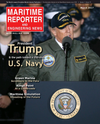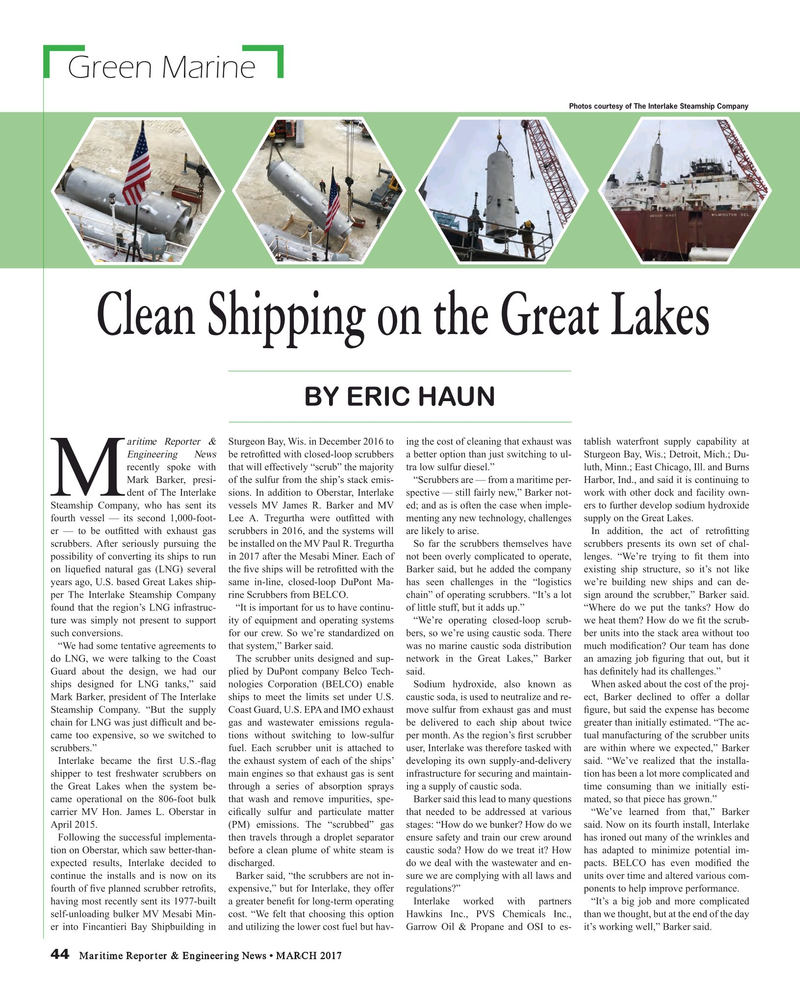
Page 44: of Maritime Reporter Magazine (March 2017)
U.S. Navy Quarterly & Maritime Simulation Technologies
Read this page in Pdf, Flash or Html5 edition of March 2017 Maritime Reporter Magazine
Green Marine
Photos courtesy of The Interlake Steamship Company
Clean Shipping on the Great Lakes
BY ERIC HAUN aritime Reporter & Sturgeon Bay, Wis. in December 2016 to ing the cost of cleaning that exhaust was tablish waterfront supply capability at
Engineering News be retro? tted with closed-loop scrubbers a better option than just switching to ul- Sturgeon Bay, Wis.; Detroit, Mich.; Du- recently spoke with that will effectively “scrub” the majority tra low sulfur diesel.” luth, Minn.; East Chicago, Ill. and Burns
Mark Barker, presi- of the sulfur from the ship’s stack emis- “Scrubbers are — from a maritime per- Harbor, Ind., and said it is continuing to
Mdent of The Interlake sions. In addition to Oberstar, Interlake spective — still fairly new,” Barker not- work with other dock and facility own-
Steamship Company, who has sent its vessels MV James R. Barker and MV ed; and as is often the case when imple- ers to further develop sodium hydroxide fourth vessel — its second 1,000-foot- Lee A. Tregurtha were out? tted with menting any new technology, challenges supply on the Great Lakes.
er — to be out? tted with exhaust gas scrubbers in 2016, and the systems will are likely to arise. In addition, the act of retro? tting scrubbers. After seriously pursuing the be installed on the MV Paul R. Tregurtha So far the scrubbers themselves have scrubbers presents its own set of chal- possibility of converting its ships to run in 2017 after the Mesabi Miner. Each of not been overly complicated to operate, lenges. “We’re trying to ? t them into on lique? ed natural gas (LNG) several the ? ve ships will be retro? tted with the Barker said, but he added the company existing ship structure, so it’s not like years ago, U.S. based Great Lakes ship- same in-line, closed-loop DuPont Ma- has seen challenges in the “logistics we’re building new ships and can de- per The Interlake Steamship Company rine Scrubbers from BELCO. chain” of operating scrubbers. “It’s a lot sign around the scrubber,” Barker said. found that the region’s LNG infrastruc- “It is important for us to have continu- of little stuff, but it adds up.” “Where do we put the tanks? How do ture was simply not present to support ity of equipment and operating systems “We’re operating closed-loop scrub- we heat them? How do we ? t the scrub- such conversions. for our crew. So we’re standardized on bers, so we’re using caustic soda. There ber units into the stack area without too “We had some tentative agreements to that system,” Barker said. was no marine caustic soda distribution much modi? cation? Our team has done do LNG, we were talking to the Coast The scrubber units designed and sup- network in the Great Lakes,” Barker an amazing job ? guring that out, but it
Guard about the design, we had our plied by DuPont company Belco Tech- said. has de? nitely had its challenges.” ships designed for LNG tanks,” said nologies Corporation (BELCO) enable Sodium hydroxide, also known as When asked about the cost of the proj-
Mark Barker, president of The Interlake ships to meet the limits set under U.S. caustic soda, is used to neutralize and re- ect, Barker declined to offer a dollar
Steamship Company. “But the supply Coast Guard, U.S. EPA and IMO exhaust move sulfur from exhaust gas and must ? gure, but said the expense has become chain for LNG was just dif? cult and be- gas and wastewater emissions regula- be delivered to each ship about twice greater than initially estimated. “The ac- came too expensive, so we switched to tions without switching to low-sulfur per month. As the region’s ? rst scrubber tual manufacturing of the scrubber units scrubbers.” fuel. Each scrubber unit is attached to user, Interlake was therefore tasked with are within where we expected,” Barker
Interlake became the ? rst U.S.-? ag the exhaust system of each of the ships’ developing its own supply-and-delivery said. “We’ve realized that the installa- shipper to test freshwater scrubbers on main engines so that exhaust gas is sent infrastructure for securing and maintain- tion has been a lot more complicated and the Great Lakes when the system be- through a series of absorption sprays ing a supply of caustic soda. time consuming than we initially esti- came operational on the 806-foot bulk that wash and remove impurities, spe- Barker said this lead to many questions mated, so that piece has grown.” carrier MV Hon. James L. Oberstar in ci? cally sulfur and particulate matter that needed to be addressed at various “We’ve learned from that,” Barker
April 2015. (PM) emissions. The “scrubbed” gas stages: “How do we bunker? How do we said. Now on its fourth install, Interlake
Following the successful implementa- then travels through a droplet separator ensure safety and train our crew around has ironed out many of the wrinkles and tion on Oberstar, which saw better-than- before a clean plume of white steam is caustic soda? How do we treat it? How has adapted to minimize potential im- expected results, Interlake decided to discharged. do we deal with the wastewater and en- pacts. BELCO has even modi? ed the continue the installs and is now on its Barker said, “the scrubbers are not in- sure we are complying with all laws and units over time and altered various com- fourth of ? ve planned scrubber retro? ts, expensive,” but for Interlake, they offer regulations?” ponents to help improve performance. having most recently sent its 1977-built a greater bene? t for long-term operating Interlake worked with partners “It’s a big job and more complicated self-unloading bulker MV Mesabi Min- cost. “We felt that choosing this option Hawkins Inc., PVS Chemicals Inc., than we thought, but at the end of the day er into Fincantieri Bay Shipbuilding in and utilizing the lower cost fuel but hav- Garrow Oil & Propane and OSI to es- it’s working well,” Barker said.
44 Maritime Reporter & Engineering News • MARCH 2017
MR #3 (42-49).indd 44 MR #3 (42-49).indd 44 3/6/2017 11:41:47 AM3/6/2017 11:41:47 AM

 43
43

 45
45
